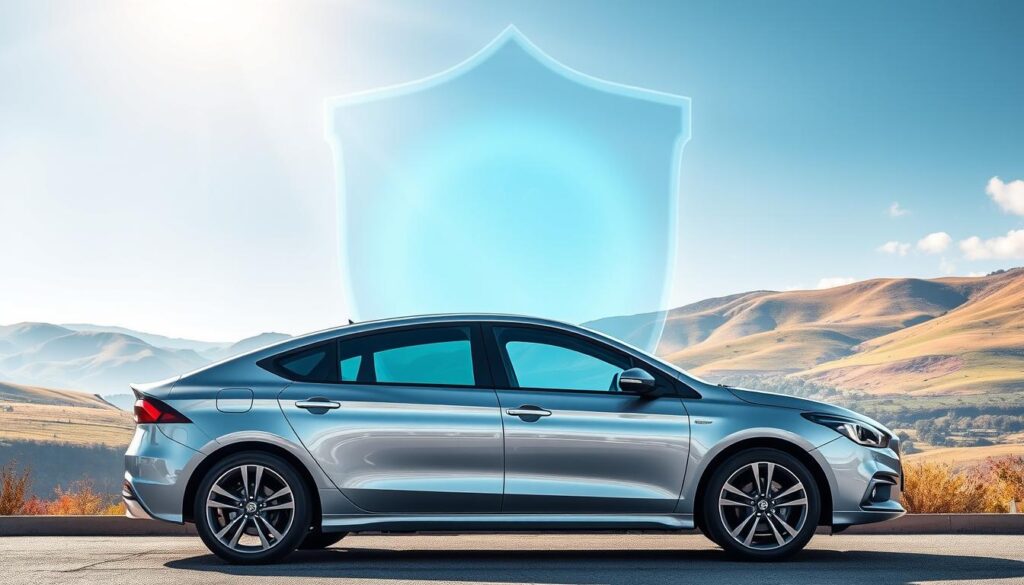Having a car means you face big financial risks. Auto insurance is key to protect you, your car, and your money. It covers many risks and losses that come with driving.
There are different types of coverage in auto insurance. Each one has its own job to keep you safe financially. This includes liability, collision, and comprehensive protection.
Key Takeaways
- Auto liability coverage is required by law in nearly every state to meet minimum insurance requirements.
- Comprehensive and collision coverage are optional but recommended to protect your vehicle from damages.
- Medical payments and personal injury protection can help cover accident-related medical expenses.
- Uninsured/underinsured motorist coverage safeguards you from drivers without adequate insurance.
- Additional protection options like gap insurance and roadside assistance provide further financial security.
Understanding Basic Auto Insurance Requirements
Most states require drivers to have a certain level of auto insurance. This usually includes liability protection. It helps cover costs for injuries or damage caused by the driver in an accident. Knowing these minimums is key for drivers to follow the law and stay protected.
State-Mandated Coverage Minimums
Almost every state requires Bodily Injury Liability coverage. This pays for injuries and death caused by the driver. Property Damage Liability coverage is also common, covering damage to other vehicles or property.
Many states also require Medical Payments or Personal Injury Protection (PIP) coverage. This helps with medical bills from accidents.
Legal Obligations for Drivers
It’s wise to get more than the minimum insurance. This protects your home and savings in case of a big accident. Uninsured Motorist Coverage is also common. It helps if hit by an uninsured driver or in a hit-and-run.
Cost Factors in Basic Coverage
The cost of basic auto insurance varies. It depends on state laws, the driver’s history, and the vehicle type. Knowing these factors can help find affordable coverage that meets legal needs.
“Protecting yourself and others on the road is paramount, and having the right auto insurance coverage is the first step in that process.”
Essential Liability Coverage Components

Liability coverage is key in auto insurance. It protects drivers from costs for damages to others. It has two main parts: bodily injury liability and property damage liability.
Bodily injury liability pays for medical bills and lost wages of those hurt in an accident. Property damage liability covers the cost to fix or replace damaged vehicles or property.
Most states require a minimum of liability coverage. But, it’s wise to increase these limits for more protection. Higher limits can offer extra financial security in serious accidents.
| Coverage Type | What It Covers |
|---|---|
| Bodily Injury Liability | Medical expenses and lost wages of injured parties |
| Property Damage Liability | Repairs or replacement of the other vehicle or damaged property |
Businesses also need commercial general liability insurance for protection. This covers legal costs, settlements, or judgments from third-party claims. It’s for cases of alleged negligence or wrongdoing.
Knowing about liability coverage and its limits is vital. It helps drivers protect their finances and follow state laws. With liability protection, drivers can feel secure, knowing they’re covered in accidents.
Comprehensive and Collision Coverage Explained

Protecting your vehicle is key, and comprehensive and collision coverage are vital. These coverages help keep your investment safe. They offer financial security when unexpected damages or accidents happen.
Protection Against Non-Collision Damages
Comprehensive coverage protects against theft, vandalism, natural disasters, and more. It helps cover repair costs or replace your vehicle if it’s a total loss.
Collision Damage Protection
Collision coverage helps when your vehicle hits another or an object. It covers repair or replacement costs, no matter who’s at fault.
Deductible Considerations
Deductibles are part of both coverages. They’re the amount you pay before insurance kicks in. A higher deductible means lower premiums but more out-of-pocket costs. Choosing the right deductible balances coverage and budget.
| Coverage Type | Typical Cost | Deductible Impact | Recommended Scenarios |
|---|---|---|---|
| Comprehensive | Usually less expensive than collision | Higher deductible = lower premium | Protecting against theft, vandalism, and natural disasters |
| Collision | Usually more expensive than comprehensive | Higher deductible = lower premium | Covering repair costs after an accident, regardless of fault |
Comprehensive and collision coverage are not mandatory but often required for financed or leased vehicles. The choice depends on your vehicle’s value, driving habits, and risk tolerance.
Medical Payments and Personal Injury Protection

Auto insurance has two key coverages: medical payments coverage (MedPay) and personal injury protection (PIP). They help pay for costs from car accidents. This includes medical bills, lost wages, and other expenses.
Medical Payments (MedPay) Coverage pays for medical costs for you and your passengers. It doesn’t matter who caused the accident. It’s required in Maine and New Hampshire but is useful everywhere. It’s great for those with high medical bills or little health insurance.
Personal Injury Protection (PIP) does similar things as MedPay but also covers lost wages and other costs. It’s needed in “no-fault” states where your insurance pays first, not the other driver’s. Delaware and Oregon are the only tort states that require PIP.
| Coverage | Description | Mandatory States |
|---|---|---|
| Medical Payments (MedPay) | Covers medical expenses for you and your passengers after an accident, regardless of fault | Maine, New Hampshire |
| Personal Injury Protection (PIP) | Covers medical expenses, lost wages, and other accident-related costs, regardless of fault | No-fault states (e.g., New York, New Jersey, Florida) |
Knowing what MedPay and PIP cover in your state is key. They offer different benefits. Talk to your insurance provider to make sure you have the right coverage. This will protect you and your passengers in case of an accident.
Coverage for Uninsured and Underinsured Motorists

Auto insurance is key. It’s important to have the right coverage. This includes protection against uninsured and underinsured motorists. Uninsured motorist coverage (UM) and underinsured motorist coverage (UIM) are crucial if you’re in an accident with someone who doesn’t have enough or any insurance.
Protection Against Uninsured Drivers
About 13% of drivers in the U.S. don’t have auto insurance. In some places, this number is over 20%. Uninsured Motorist Bodily Injury (UMBI) coverage helps with medical costs, funeral expenses, lost wages, and pain and suffering if you’re hit by an uninsured driver. Uninsured Motorist Property Damage (UMPD) coverage covers your car’s repairs, up to its actual cash value.
Understanding Gap Coverage Needs
Gap insurance is also important. It covers the gap between your car’s value and what you still owe if it’s totaled. This ensures you’re not stuck making payments on a car you no longer have.
Claims Process Guidelines
Filing a claim for uninsured or underinsured motorist coverage needs to be understood. Know the specific requirements and documents needed in your state. Keeping good records and working with your insurance can make the process smoother.
| Coverage Type | Description | State Requirements |
|---|---|---|
| Uninsured Motorist Bodily Injury (UMBI) | Covers medical expenses, lost wages, and pain and suffering if you’re injured by an uninsured driver. | Around half of the states require UMBI coverage. Illinois, New Hampshire, and a few others mandate it. |
| Uninsured Motorist Property Damage (UMPD) | Covers repairs to your vehicle if it’s damaged by an uninsured driver, up to the car’s actual cash value. | State requirements for UMPD deductibles may differ from UMBI/UIM coverage. |
| Underinsured Motorist Coverage (UIM) | Provides protection if you’re involved in an accident with a driver who lacks sufficient insurance to cover your injuries or damages. | Around half of the states require UIM coverage. Illinois and New Hampshire mandate both UMBI and UIM. |
| Gap Insurance | Covers the difference between your car’s actual cash value and the amount you still owe on your loan or lease if your vehicle is totaled. | Gap insurance requirements vary by state and lender. It’s generally not mandated by law but can be a valuable addition to your policy. |
Understanding uninsured and underinsured motorist coverage and the claims process is key. This ensures drivers are protected if they’re in an accident with someone who doesn’t have enough insurance.
Additional Protection Options
Many auto insurers offer extra protection options to boost your policy. These include roadside assistance, rental car coverage, and new car replacement insurance. For example, COUNTRY’s The Keeper® program covers the cost of a brand-new car if your new one is severely damaged.
These extra coverages let drivers customize their policies. Roadside assistance can cover towing, fuel delivery, and minor repairs. Rental car coverage helps pay for a temporary car during repairs. New car replacement coverage is great for protecting a new vehicle.
Insurers also offer add-ons for custom parts, pet injury, and rideshare insurance. This way, you can make sure your auto policy fits your specific needs. By looking into these options, you can get the right coverage for you.
Also Read : The Basics Of Long-term Care Insurance: Planning For The Future
FAQs
Q: What is the definition of health coverage?
A: Health coverage refers to the insurance that pays for medical and surgical expenses incurred by the insured. It can also provide coverage for preventive care services.
Q: How does a health insurance program relate to the concept of universal health?
A: A health insurance program aims to provide health coverage to all individuals, moving toward the goal of universal health, which is the ideal system where everyone has access to necessary health services without financial hardship.
Q: What is the purpose of a health services survey?
A: A health services survey gathers data on how health care is accessed and utilized, providing insights into the effectiveness of health coverage and identifying areas for improvement in the health system.
Q: What is the significance of preventive care in health coverage?
A: Preventive care is crucial as it helps in early detection and prevention of diseases, reducing overall health care costs and improving the long-term health of individuals, which is often included in health insurance programs.
Q: Can Americans access Medicaid and Medicare under the same health coverage plans?
A: No, Medicaid and Medicare are separate health insurance programs. Medicaid provides health coverage for low-income individuals, while Medicare is primarily for those aged 65 and older, or for younger individuals with disabilities.
Q: What are the eligibility requirements for the Children’s Health Insurance Program (CHIP)?
A: CHIP provides health coverage for children in families with incomes too high to qualify for Medicaid but too low to afford private health insurance. Eligibility varies by state, and families can check their state’s gov website for specific details.
Q: How can a quiz help individuals understand their health coverage options?
A: A quiz can assess an individual’s knowledge about different health coverage plans, eligibility criteria, and benefits, helping them make informed decisions about their healthcare needs.
Q: What should I look for in a health plan’s definition of coverage?
A: When reviewing a health plan’s definition of coverage, look for details on the types of services included, any exclusions, the scope of coverage for preventive care, and how it addresses chronic conditions.
Q: How does the health care system in 2023 differ from previous years?
A: The health care system in 2023 has seen changes in policy and coverage options, particularly with the expansion of telehealth services and adjustments in health care costs, aimed at improving accessibility for all Americans.
Source Links
- https://www.progressive.com/answers/types-of-car-insurance/
- https://www.geico.com/information/aboutinsurance/auto/
- https://www.bankrate.com/insurance/car/coverage-types/

